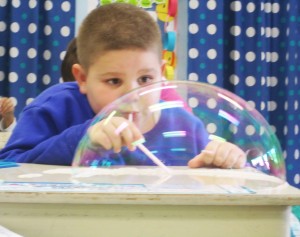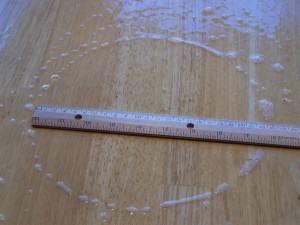Engaging Science Activities For Children!
The Dancing Popcorn
Topic: Buoyancy
This interesting activity fosters critical thinking skills through observation, as children try to figure out why popcorn sinks and floats in a carbonated beverage. Dump some popcorn kernels into any clear plastic container. A clear glass or cup works fine. Now open a bottle of seltzer or club soda (careful now), and pour it into the container. Watch the dance of the popcorn!

When enough bubbles cover the popcorn kernel, it floats up to the top.

When enough bubbles pop at the top, the popcorn sinks back down to the bottom.
Straw Liquid Layers
Topic: Density
 Salt and sugars solutions of different denstities can be layered using a straw. Dip the straw about an inch into the liquid and place your finger over the top of the straw. Lift the straw out, keeping the finger on the straw. As long as a finger remains on the opening of the straw, the liquid will stay in the straw. Now place the straw in the second solution, going about an inch deeper. Slowly remove the finger and the second liquid will enter the straw. Place your finger
Salt and sugars solutions of different denstities can be layered using a straw. Dip the straw about an inch into the liquid and place your finger over the top of the straw. Lift the straw out, keeping the finger on the straw. As long as a finger remains on the opening of the straw, the liquid will stay in the straw. Now place the straw in the second solution, going about an inch deeper. Slowly remove the finger and the second liquid will enter the straw. Place your fingerback on the straw and lift it out of the cup. Repeat this procedure for the other liquid, always remembering to keep a finger on the straw whenever it is pulled out of the liquids. Afterward, the straw can be stuck into a piece of clay so that the liquids remain in the straw.
How Many Drops fit on a Penny?
Topic: Surface Tension
Surface tension is the reason water forms drops. If you place water onto a flat surface such as a coin, the water does not run flat over the sides. Instead, a dome of water forms. This is because of surface tension: the water molecules at the surface pull toward each other and prevent the water from running flat. This is also why beads of water appear on leaves of plants when dew forms. This is a classic activity in which students count the number of drops of water from a pipet or eye dropper that can fit on a penny.

Other Inquiry Experiments
- How many drops can a dime, nickel, or quarter hold?
- Compare other liquids such as salt water, vinegar, or juices.
- Compare warm water to cold water.
- Does the other side of the penny hold the same amount of water?
- Compare different droppers (a baster is fun!).
Table top Bubbles
Topic: Surface Tension and Measurement

An interesting method to blow bubbles is on the top of a table or desk. Pour some of the bubble liquid onto the surface of a table and spread it out. Take a straw, dip it into the bubble solution, and blow a bubble on the table where the liquid is. When the bubble pops, it leaves behind a ring of smaller bubbles around the circumference. This lets students measure both the circumference and the diameter of the popped bubble easily.

